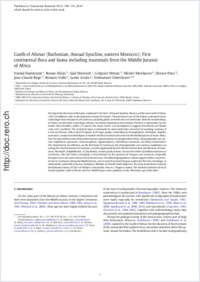Guelb el Ahmar (Bathonian, Anoual Syncline, eastern Morocco): First continental flora and fauna including mammals from the Middle Jurassic of Africa
- Haddoumi, Hamid Département de Géologie, Faculté des Sciences, Université Mohammed 1er, Oujda, Morocco
- Allain, Ronan CR2P — Centre de Recherches sur la Paléobiodiversité et les Paléoenvironnements, UMR 7207, Muséum National d'Histoire Naturelle, Paris, France
- Meslouh, Said Ministère de l'Energie, des Mines, de l'Eau et de l'Environnement, Rabat, Morocco
- Metais, Grégoire CR2P — Centre de Recherches sur la Paléobiodiversité et les Paléoenvironnements, UMR 7207, Muséum National d'Histoire Naturelle, Paris, France
- Monbaron, Michel Département de Géosciences, Université de Fribourg, Switzerland
- Pons, Denise CR2P — Centre de Recherches sur la Paléobiodiversité et les Paléoenvironnements, UMR 7207, Muséum National d'Histoire Naturelle, Paris, France
- Rage, Jean-Claude CR2P — Centre de Recherches sur la Paléobiodiversité et les Paléoenvironnements, UMR 7207, Muséum National d'Histoire Naturelle, Paris, France
- Vullo, Romain UMR-CNRS 6118, Géosciences Rennes, Université de Rennes 1, France
- Zouhri, Samir Laboratoire de Géosciences, Faculté des Sciences Aïn Chock, Université Hassan II de Casablanca, Morocco
- Gheerbrant, Emmanuel CR2P — Centre de Recherches sur la Paléobiodiversité et les Paléoenvironnements, UMR 7207, Muséum National d'Histoire Naturelle, Paris, France
-
07.01.2015
Published in:
- Gondwana Research. - 2016, vol. 29, no. 1, p. 290–319
English
We report the discovery in Mesozoic continental “red beds” of Anoual Syncline, Morocco, of the new Guelb el Ahmar (GEA) fossiliferous sites in the Bathonian Anoual Formation. They produced one of the richest continental biotic assemblages from the Jurassic of Gondwana, including plants, invertebrates and vertebrates. Both the sedimentological facies and the biotic assemblage indicate a lacustrine depositional environment. The flora is represented by tree trunks (three families), pollen (13 species, five major clades) and charophytes. It suggests local forests and humid (non-arid) conditions. The vertebrate fauna is dominated by microvertebrates recovered by screening–washing. It is rich and diverse, with at least 29 species of all major groups (osteichthyans, lissamphibians, chelonians, diapsids, mammals), except chondrichthyans. It includes the first mammals discovered in the Middle Jurassic of Arabo-Africa. The GEA sites yielded some of the earliest known representatives of osteoglossiform fishes, albanerpetontid and caudate amphibians, squamates (scincomorphans, anguimorphan), cladotherian mammals, and likely choristoderes. The choristoderes, if confirmed, are the first found in Gondwana, the albanerpetontid and caudatan amphibians are among the very few known in Gondwana, and the anguimorph lizard is the first known from the Mesozoic of Gondwana. Mammals (Amphitheriida, cf. Dryolestida) remain poorly known, but are the earliest cladotherians known in Gondwana. The GEA biotic assemblage is characterized by the presence of Pangean and Laurasian (especially European) taxa, and quasi absence of Gondwanan taxa. The paleobiogeographical analysis suggests either a major fossil bias in Gondwana during the Middle Jurassic, and an overall vicariant Pangean context for the GEA assemblage, or alternatively, noticeable Laurasian (European) affinities and North-South dispersals. The close resemblance between the Bathonian faunas of GEA and Britain is remarkable, even in a Pangean context. The similarity between the local Anoual Syncline Guelb el Ahmar and Ksar Metlili faunas raises questions on the ?Berriasian age of the latter.
- Faculty
- Faculté des sciences et de médecine
- Department
- Département de Géosciences
- Language
-
- English
- Classification
- Palaeontology
- License
- License undefined
- Identifiers
-
- RERO DOC 258861
- DOI 10.1016/j.gr.2014.12.004
- Persistent URL
- https://folia.unifr.ch/unifr/documents/304786
Statistics
Document views: 92
File downloads:
- mon_gab.pdf: 706
